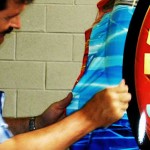Stick It In Reverse How you apply an application tape to a vinyl graphic or a HotMask™ transfer tape to a printed heat transfer applique can affect the appearance of the finished product. If you get wrinkles or bubbles in the paper application tape, I can just about guarantee that you will get wrinkles and […] Read more »
Arlon’s DPF 8000
An Ideal Solution for Wall Graphics Many shops, which have printed wall murals in which the ink bleeds to the edge of the panel, have experienced edge curl issues with a variety of vinyl films. For permanent wall graphics applications, I would consider using Arlon’s DPF 8000 film. DPF 8000 is a 3.5 mil (90 […] Read more »
Picture Perfect Wall Graphics
Applications to Smooth Walls Applying graphics to a flat, smooth, painted wall is easy. Still problems can and do occur. Rarely are these graphics failures the result of application technique. Instead improper surface preparation and poor material choices account for most problems. If you follow the few simple rules in this article, your applications should […] Read more »
Are Premask and Prespacing Tape the Same Thing?
The plethora of terms used for the application tapes sold in the sign and screen print markets could confuse anyone. In the sign market, many people just use the terms “application tape” or “application paper”. Frequently this tape is also incorrectly referred to as “transfer tape”. If you are a purist and want to pick a […] Read more »
Preparing Floors for Floor Graphics
Learn how to how to laminate the graphic, how to place it, how to prep the surface, and how to install the graphic so it will stay put and do its job. With floor graphics representing a $2 billion industry, can you really afford not to get involved? The answer for most of you is […] Read more »
Why Install Graphics in a Relaxed State
Years ago professional decal installers were taught to install vinyl graphics in a relaxed state without stretching the film. While vinyl films today are much more robust and can withstand the stresses encountered when wrapping a vehicle, you are much less likely to experience film failure, if you adhere to some of the old rules. […] Read more »
Application Temperature Range

To avoid problems with vinyl or any other pressure-sensitive material, carefully read the vinyl manufacturer’s technical data sheet. Product bulletins will usually contain all of the information you need, including application temperature range. The application temperature range for most vinyl films is usually between 50⁰ and 90⁰F (10⁰ to 32⁰ C). For some films, the […] Read more »
Problems with Static Electricity

In much of the country September ushers in climatic changes. As the autumn air becomes colder, the humidity of the air outdoors decreases. The drop in humidity can result in an increase of problems related with static electricity. Static problems in print shops are further exacerbated, as we switch from air conditioning to a heating […] Read more »
Premask Puckering on Screen Printed Graphics
A number of factors can cause puckering and tunneling of a premask or application tape laminated on a screen printed vinyl graphic. These factors fall into three broad categories: environment, material processing and product selection. Read more »
Adhesion Testing
Testing the Bond of an Ink or Paint Whether you are screen printing or painting, the coating must bond to the substrate for the service life of the product. Depending on the physical properties of the coating that you have selected for a project and the substrate to which the coating will be applied, the […] Read more »


